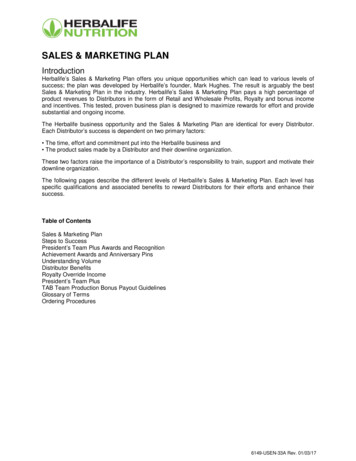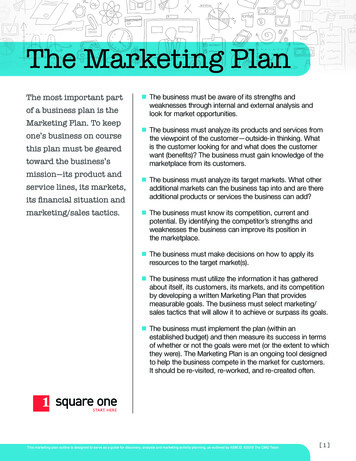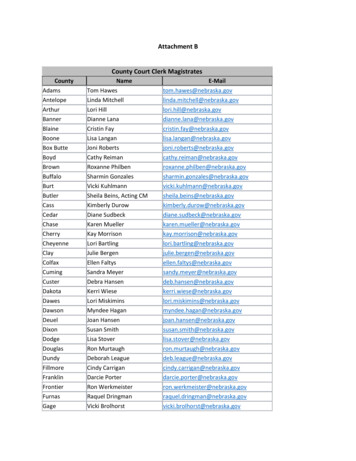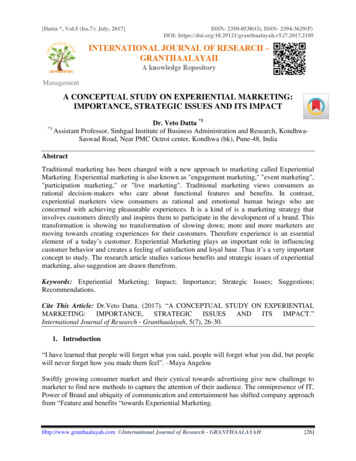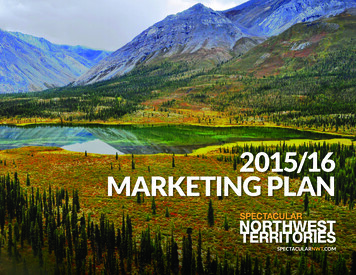
Transcription
2015/16MARKETING PLANNORTHWEST TERRITORIES TOURISM 2015/16 MARKETING PLAN 1
MAKI KAWAI / NWT TOURISM2 2015/16 MARKETING PLAN NORTHWEST TERRITORIES TOURISM
FRONTIER FISHING LODGEExecutive Summary. 04An Introduction to NWT Tourism 06NWT Tourism Vision and Mission 07NWT Tourism Marketing Plan Goals and Objectives 07The Marketing Plan Process 08The Tourism Industry at a Glance 09Challenges and Opportunities 12Our Product . 16Distribution Channels 17Market Classification 20Path to Purchase Model 22Strategic Objectives . 242015/16 Marketing Plan 312015/16 Marketing Plan Key Activities 33Budget Summary . 38Appendix A - Target Market Profiles 39Primary Markets . 40Secondary Markets . 54Long-Term Markets . 59Other Markets . 67FRONT COVER: MACKENZIE MOUNTAINS, BENJI STRAKER, NWT PARKS, ITI, GNWTBACK COVER: AURORA NEAR YELLOWKNIFE, MAKI KAWAI, NWT TOURISMNORTHWEST TERRITORIES TOURISM 2015/16 MARKETING PLAN 3
EXECUTIVE SUMMARYAlthough overall visitor numbers and spendingincreased in 2013-14, there is still much to bedone to grow the tourism industry in all sectorsand regions of the Northwest Territories. Sportfishing, outdoor adventure and regional packagesand events have special marketing needs which weaddress in this plan. And we will continue to workwith NWT operators to grow the Aurora, generaltouring and business travel markets, especially theconference and meetings market.This 2015/16 marketing plan guides all ofNorthwest Territories Tourism’s marketingactivities. The plan is developed annually basedon consultation and feedback from our keystakeholders, including the Tourism MarketingAdvisory Committee, the NWTT Board ofDirectors, the Aboriginal Tourism ChampionsAdvisory Council, regional, aboriginal andcommunity governments, NWTT members,NWTT General Sales Agents (GSAs), the CanadianTourism Commission (CTC), and consideration ofextensive research done by the CTC, ITI and theindependent research recently completed by theEnvironics Research Group for NWTT.The plan also addresses a number of issues andchallenges. Earlier plans were sector-based,4 2015/16 MARKETING PLAN NORTHWEST TERRITORIES TOURISMwhich meant allocating small budgets to arange of sectors. Several years ago we movedto an integrated plan, which focused on overallawareness of NWT sector products and services.These larger integrated plans used mass media(Globe and Mail and CBC TV ads) to introduce theNWT destination to a wider group of potentialtravellers. In 2015/16 we will continue awarenessmarketing, but will devote more resources to nicheor sector products, and will have a greater focus onregional marketing.Other tourism marketing plan challenges includedthe timing and size of the plan.To allow for more feedback we now circulate a firstdraft of the plan in July/August, so we can makemodifications prior to submitting it to TMAC forfinal approval in January. We have also reducedthe size of the plan, although we have retainedimportant sections such as industry overview,challenges and opportunities, distributionchannels and market profiles.This year we have increased the emphasis onstrategies, objectives and tactics, have includedmore focus on regions, have attempted to achievea workable balance between general awarenessand sector advertising and have condensed themarketing activity section.For the upcoming year we have identified ninestrategic objectives as follows:1. Strengthen the Spectacular brandand build destination awareness withstrategic brand managementNWT Tourism is committed to developing anumber of processes that will help us maintainand strengthen our brand identity, while creatingmore ways to promote it in all of our key marketsand enabling the NWT regions to showcase thedifferent products they offer within the brand.2. Increase tourism revenuesTo increase tourism revenues, NWTT will focuson the markets with the highest potential forimmediate and long-term success.3. Drive visitation to all regions of theNorthwest TerritoriesNWT Tourism recognizes that visitation to manyof our regions is down and will be making aconcerted effort to help drive more traffic to theregions via a number of new initiatives.
4. Revitalize the sport fishing sector7. Endorse and showcase excellenceNWT Tourism, working with ITI has completedextensive research on the sport fishing marketand is using this research for the ongoingimplementation of a sport fishing marketingstrategy. A specific budget has been allocated tothis initiative in 2015/16, similar to 2014/15.NWTT will endorse excellence and will workclosely with GNWT/ITI, regional partners andlocal operators to instill a sense of pride inperformance. With the GNWT we will alsoexplore establishing training standards.5. Develop strategic partnershipsthat lead to stronger packages for longerstaysNWT Tourism will work closely with Federal,Territorial and regional governments and privatesector (local tourism operators) to ensure thatall partners are aligned and working towards thecommon goal of creating market-ready packagesthat are attractive to the consumer.6. Engage the local tourism industryNWTT will create more opportunities forstakeholder involvement including participation inmarketing programs and will offer more supportfor product packaging. We will also work toenhance the importance of the industry to NWTresidents and the NWT economy.8. Identify opportunities for the futureNWT Tourism will investigate futureopportunities and develop related marketingplans around events such as the opening of theInuvik to Tuk highway and the celebration ofCanada’s 150th birthday.9. Manage success through keyperformance measuresNWT Tourism is committed to working closerwith ITI, our regional partners and tourismoperators to establish meaningful performancemeasures, which could include the number ofvisitors and visitor spending, as well as VisitorInformation Centre numbers, total number ofpackages sold, event attendance numbers, hoteloccupancy rates, etc.Marketing activities will focus on our key markets(Canada, Japan, China, Germany and the USA)and will continue to use our four main distributionchannels –consumer, media, travel trade andmeeting and incentive travel.The proposed marketing budget for 2015/16activities is 3,484,545, similar to the 2014/15marketing budget. Of this amount 2,784,545 isprovided by GNWT/ITI and 700,000 is from oursuccessful CanNor application. The GNWT fundsare broken into two categories: core marketingand Tourism 2015. The core marketing funds of 2,384,545 cover consumer marketing, mediapromotions, trade promotions and MC&IT. Closeto 70% of this amount will be directed to theCanadian market.Tourism 2015 funds total 370,000 and areallocated to regional marketing, local marketingand special marketing initiatives.CanNor funds will be used to enhance our currentmarkets ( 400,000) and to develop new marketsfor NWT tourism products ( 300,000).NWT Tourism believes that the successfulexecution of this marketing plan and strategywill contribute to achieving value and volumeimprovements for the NWT tourism industry.NORTHWEST TERRITORIES TOURISM 2015/16 MARKETING PLAN 5
GEROLD SIGL / NWT TOURISMAN INTRODUCTIONTO NWT TOURISMNorthwest Territories Tourism (NWT Tourism) is a non-profit organizationserving close to 200 members whose businesses involve the tourismindustry. Through funding contribution agreements with the Government ofthe Northwest Territories, NWT Tourism undertakes all of the destinationmarketing activities for the Northwest Territories and works to enhancethese efforts through other partnerships and funding agreements. Theorganization uses a variety of innovative marketing strategies to help builddestination awareness and to drive business to our local tourism operators.NWT Tourism actively promotes all NWT regions and tourism sectors to ourkey domestic and international markets. NWT Tourism works closely with avariety of local, regional, national and international partners to establish ourbrand, uphold its reputation and to increase visitor revenues to the NWT.6 2015/16 MARKETING PLAN NORTHWEST TERRITORIES TOURISM
HANS PFAFF / NWT TOURISMNORTHWEST TERRITORIES TOURISMVISION AND MISSIONVISIONA thriving, vibrant, sustainable and successful tourism industryMISSIONTo grow the tourism industry for the NWT in order to support a strongand sustainable economyNORTHWEST TERRITORIES TOURISMMARKETING PLANGOALS AND OBJECTIVESGOALTo increase the number of visitors and visitor spending in the NWTOBJECTIVES To increase destination awareness To strategically promote all tourism sectors in the NWT To drive traffic to all regions of the NWTNORTHWEST TERRITORIES TOURISM 2015/16 MARKETING PLAN 7
THE MARKETING PLAN PROCESSThe 2015/16 NWT Tourism marketing planoutlines the markets and marketing activities wewill undertake to achieve the goal of increasingvisitor revenues for the NWT. The marketingplan builds on the foundation of previousmarketing plans, supports implementation ofthe GNWT’s Economic Opportunities Strategyand includes a number of new strategies that willhelp create efficiencies, build new partnershipsand strengthen existing ones, diversify ourproduct offerings, reinforce our unique sellingposition and grow tourism revenues in all regionsof the NWT.Aboriginal Tourism is seen to be a sector withpotential for growth. Its potential for successis underpinned by the uniqueness and vibrancyof Aboriginal culture in NWT communities.Recommendations made by the AboriginalTourism Champions Advisory Council, anadvisory body that advises the Minister ofIndustry, Tourism and Investment (ITI), regardingthe development and growth of Aboriginaltourism, have been reviewed and taken intoconsideration in the development of this plan.As part of the process for developing theannual marketing plan, the Tourism Marketing8 2015/16 MARKETING PLAN NORTHWEST TERRITORIES TOURISMAdvisory Committee (TMAC) providesindependent strategic advice to the Minister ofITI on marketing the NWT, recommends finalmarketing plans and strategies to the ministerand recommends adjustments to the annualmarketing plan where required.NWT Tourism also utilized market intelligenceand research provided by the Governmentof the Northwest Territories, Department ofIndustry, Tourism and Investment (ITI), theCanadian Tourism Commission (CTC) and, ourown research conducted in partnership withthe GNWT in 2014 with respect to the fishingsector as a guide for selecting and prioritizingour target markets. NWT Tourism also talkedwith tourism operators, tourism developmentofficers, town councils, aboriginal organizations,city governments, trade and tourism committeesand others in each of the five regions over thesummer of 2014 to gain insight into the uniquechallenges they face and to better understandthe opportunities to work together to increasevisitors and visitor spending into all five regions.Our ongoing dialogue with the regions as wedeveloped this plan enabled NWT Tourism topresent the regional ITI staff, who are importantmarketing partners, with a number of strategiesthat we were considering and then through ourdiscussion with them to narrow our strategiesdown for incorporation into the marketing plan.This ensured that the regions were on boardwith the strategies and direction presentedin this plan. Our continued dialogue with theregions as we execute this plan will providefurther opportunities for the regions to sharetheir feedback on how we could enhance thesestrategies together.The 2015/16 plan prioritizes our marketsand focuses on marketing activities that havethe most potential for success, taking intoconsideration both immediate, short termand longer term goals. When setting goalsand objectives for the plan, NWT Tourism wasmindful of the many challenges the industryfaces, such as economic recessions, volatilecurrency rates, passport/visa issues and naturaldisasters, including the recent forest firesituation in the NWT, to name a few. Existinginfrastructure and the potential for newproducts and packages were also taken intoconsideration.
TOURISM INDUSTRY AT A GLANCEWORLD VIEWTOURISM IN CANADADespite economic recovery that has beenslower than expected, demand for internationaltravel continues to grow. Over the first fourmonths of 2014, tourism worldwide grew by5 % as destinations worldwide received 317million visitors. This is an increase of over 14million tourists from the same time period in theprevious year.Domestic travel continues to be the main marketfor most Canadian Destination MarketingOrganizations, with just over 80% of visitorspending coming from the domestic market.This is up from 67% in 2000. With the economyslowly beginning to recover, Canadian travellersappear modestly optimistic about their futuretravel plans. In 2013, all major tourism indicatorsfor Canada, including tourism revenue, GDP,arrivals and employment increased. In 2013Canada welcomed approximately 15 millionvisitors from our key international markets.This was an increase of 1.76 %. The United Statesremains the largest international market forCanada, followed by the United Kingdom,France and Germany.There are a number of emerging trends in theworld tourism industry including increasedcompetition as more countries around the worldare aggressively marketing their destinationsand creating increased competition for marketshare. There is also a growing trend for high-endexperiential travel as more wealthy travellersare looking for and are willing to pay for unique,authentic experiences. Technology continues toplay a key role in the travel industry as touristsare increasingly relying on web and socialmedia platforms to select and share their travelexperiences.OVERNIGHT ARRIVALSTO CANADAUSA20122013% 226,210224,857-0.60%China216,097352,59663.17%South 20%14,739,40214,999,2381.76%BrazilTotalsNORTHWEST TERRITORIES TOURISM 2015/16 MARKETING PLAN 9
TOURISM IN THE NORTHWEST TERRITORIESTourism continues to play an important role inthe economy of the NWT.In 2013/14 the NWT received 132.5 millionin visitor revenues. This is a 24% increase fromthe previous year. Consistent with most otherregions of Canada, domestic tourism makesup about 80% of the NWT Market. The Aurorasector showed the biggest increase as over21,700 visitors came to experience our Auroraproduct, which was an increase of 38% over theprevious year. Aurora visitor revenues totaled 21 million in tourism revenues, which wasa 38% increase from the 2012/13 fiscal year.The business travel sector also experiencedsignificant growth.While the number of visitors and visitorspending increased, certain sectors continuedto experience declines. The sport fishing sectorcontinues to be the hardest hit with visitorrevenues decreasing by 1.1 million from theprevious year. Over that same time period, theoutdoor adventure also experienced a significantdecline.NWT VISITOR 14% Changefrom2012/13to 2013/14Aurora 0013,40015,20014,800-3%9407604404805005101%Outdoor g Friends & l Leisure ness 068,06065,24064,38076,40091,81020%General TouringHunting12Total VisitorsThe number of hunters is rounded to the nearest ten because the totals are less than 1,000.2Includes guided and unguided trips1NWT VISITOR % Changefrom2012/13 5.92%Outdoor Adventure6.86.15.85.26.04.1-32%Visiting Friends & Relatives4.05.46.67.28.48.96%Total Leisure Visitors55.949.544.651.958.662.06%Business .4106.7132.5-24%Aurora ViewingFishing3General TouringHunting*3Total Spending (millions)MILLIONS* Methodology for calculating visitor spending for all segments was updated and revised in 2010/11.Includes guided and unguided trips310 2015/16 MARKETING PLAN NORTHWEST TERRITORIES TOURISM
The adjacent tables provide a summary ofvisitors and visitor spending statistics for allsectors of the NWT.The NWT wildfire issues during the summerof 2014 have also had an impact on visitationwith the North Slave and South Slave being thehardest hit regions. The GNWT has reportedover 350 wildfires throughout all of the NWT.The scale of the wildfires regularly impeded roadaccess into and out of the NWT as well as travelbetween regions. Many wilderness lodges havealso been impacted as encroaching wildfiresresulted in lodge operators evacuating guests,having to decline guests for safety reasons orhaving to close operations altogether. Tragically,difficult to measure the impact that the wildfiresor their related media coverage will have onfuture visitor decisions, we will be assessing thesituation by keeping abreast of any negativemedia coverage on the wildfire situation and ifnecessary will adjust our marketing messaging totake the focus off of the fires of this past summerand focus on the our pristine wilderness andother key iconic attractions. It will be importantnot to draw any additional attention to thesituation, so NWTT will only proceed with acommunication plan to address any negativeissues of the forest fires if required to do so.WESTERN ARCTIC VISITOR CENTRE STATISTICSMID-MAY TO MID-SEPTEMBER / NON-NWT RESIDENTSTotal Number of VisitorsPercentage 573,3413,796-48.26%-41.21%13.62%NORTHWEST TERRITORIES TOURISM 2015/16 MARKETING PLAN 11GEORGE FISCHER / NWT TOURISMA number of our regions are also reportingtourism declines in the number of visitors. Thedecrease in numbers to the Western Arcticregion are of particular concern as the currentnumber of visitors is far below what the regionwas receiving over a decade ago. While thenumber of visitors to the Dawson City and Inuvikvisitor information centres has been relativelystable for the past year, the number of visitors isdown by over 50% from what it was in the late1990s.some lodges were destroyed by fire and othershad the spectacular landscapes surrounding theiroperations destroyed. NWT Tourism realizesthat the wildfire situation will have a negativeimpact on visitation numbers for the 2014/15fiscal year as a number of visitors were unableto travel to the NWT while others cancelledtheir trips due to the prominent national mediacoverage and social media activity around NWT’swildfires. NWT Tourism is also aware that thepast media coverage of the wildfire situation hasthe potential to also negatively impact futureNWT visitation in the short term. While it is
PAUL VECSEI / NWT TOURISMCHALLENGES ANDOPPORTUNITIESThe global economy, political unrest, visa/passport issues, air access, volatilecurrencies, climate change, natural disasters, competition for other tourismdestinations and increased costs of doing business in the north (fuel,insurance, etc.) all impact tourism visitation.Listed on the next pages are a number of key challenges and opportunitiesthat NWT Tourism has identified as those to be addressed in developingthe strategies for the 2015/16 marketing plan. These have been identifiedthrough a variety of feedback mechanisms, including data collection,dialogue with tour operators and travel trade represenatives, throughfeedback from familiarization tours we have hosted, in conversationswith representatives in the regions and through the ongoing feedbackwe get from visitors contacting us through the Call Centre.12 2015/16 MARKETING PLAN NORTHWEST TERRITORIES TOURISM
CHALLENGESLimited Tourism ProductsAs a result of our marketing effort, andbecause the NWT offers some unique sellingpropositions, interest in the NWT continuesto grow. Unfortunately, there is a lack of bothproduct and export ready product that can bepurchased by the consumer or our travel tradepartners, and we need to be able to offer newproducts and packages. A short tourism season,aging infrastructure, and undercapitalizedoperations make it challenging for many tourismoperators to maintain and update their products.Increased CompetitionAs the global tourism economy continues togrow, more destinations from around the worldare competing for tourism dollars. Brand USAhas increased its presence in the internationalmarketplace including Canada, and newdestinations such as Iceland are aggressivelymarketing to Canadians. Most regions acrossCanada are increasing their marketing activitiesto maintain their share of the domestic market,recognizing that tourism is an economic driver.The success of our Aurora marketing hasbeen seen by other jurisdictions with similaropportunities, and new and smart packaging bycompetitors around the Aurora heightens ourneed to protect investment in this segment.High Costs of TravelAs the NWT is a long-haul destination, the highcost of travel to the NWT, coupled by the highcost of travel to move within the regions of theNWT is a significant barrier. Airline carrier fees,fuel charges, taxes and increased insurance costsresult in the NWT (and all of Canada) being oneof the higher cost destinations in the world.When fuel prices increase they are also a barrierfor rubber tire traffic.Road and Air AccessThe deteriorating condition of the LiardHighway and the highway between Behchokoand Yellowknife has deterred visitation to theNWT. Air access also continues to be a challengeas a number of our domestic and internationalvisitors are being turned away as they cannotfind available flights to the NWT or because thecost of a number of flights and the time to get tothe NWT is a concern.Aging Demographics of Our Client BaseA number of our key tourism sectors, includingsport fishing and outdoor adventure, are seeingthe average age of their client base increase.As a result their key markets are shrinking andthey are challenged with finding new markets fortheir products.Customer ServiceWhile the people of the NWT are known forbeing warm and friendly, customer serviceprovided at Visitor Reception Centres and localbusinesses can be inconsistent. As the NWT is ahigh cost destination, customers are expectinga high level of service for their investment andfeedback to our Call Centre suggests they aresometimes disappointed. Destinations able todeliver a high level of customer service withconsistency across all its tourism interfacesas well as value for money have a competitiveadvantage.NORTHWEST TERRITORIES TOURISM 2015/16 MARKETING PLAN 13
Negative Perceptions of Destinationand Weatherone close by to make a unique selling propositionfor a stay in their region.There are many misconceptions about ourdestination that come from the fact we arelocated in a cold climate area. Perceptionsthat we have to overcome are that it is coldall the time, difficult to get to, expensive andunaffordable, that there are no or few modernamenities and there is very little or nothing to dohere. The recent wildfires also have the potentialto instill a negative perception of the NWT’sspectacular beauty.The Fishing Lodge VisitorMarket is ShrinkingLimited In-Bound Tour Operatorsand Proactive PackagingThroughout our travel to the regions, consistentfeedback was that small tour operators struggleto keep their small operations afloat in shortsummer and long winter seasons and thatthey need the help of an inbound operator ormarketer in promoting and handling bookingsand packaging for their product. Specifically,small operators want to work with a businessand other partners to package their experienceor product with others in the same community or14 2015/16 MARKETING PLAN NORTHWEST TERRITORIES TOURISMFishing as an activity in general is on thedecline, so as NWT fishing lodge owners workto compete in a global market that is shrinkingand that has an aging demographic, the lodgeexperience and all it has to offer has to match orbeat other opportunities that are available forthe same price elsewhere.OPPORTUNITIESWord-Class Iconic AttractionsThe NWT has no shortage of iconic attractions.We are known as the best place to view theAurora and have established the NWT asthe Aurora Capital of the World. The NWT ishome to two UNESCO World Heritage Sites(Nahanni National Park Reserve and WoodBuffalo National Park). The legendary DempsterHighway, the Canol trail and the majestic riversof the Sahtu, along with the vibrant culture ofAboriginal communities in all five regions, offermany attractions and/or experiences that willresonate with tourists from both domestic andinternational markets.Increased Interest andAwareness of the NWTThe increased media exposure NWT has beenreceiving in recent years has helped to increasedestination awareness. TV programs such asIce Road Truckers, Ice Pilots, Ice Lake Rebels,the National Geographic feature that includedNahanni National Park Reserve as one of 20 mustsee destinations in 2014, and the designations ofWood Buffalo National Park as the world’s largestdark sky preserve and AuroraMAX have all helpedto put NWT on the map.Development of New ProductsWhile the NWT has a shortage of products, thereis always an opportunity to create new productsor stronger attraction packages by partnering.The upcoming development of an all-season roadfrom Inuvik to Tuktoyaktuk has the potentialto be developed into a fly-drive package.Partnership between Via Rail, Fraserway RVand northern airlines has the potential forintermodal packages that will drive visitation to
Partnerships with Alberta, BritishColumbia, the Yukon and NunavutNWT’s proximity with Alberta, BC and theYukon provide many opportunities to workcollaboratively to attract more visitors to ourregions. The NWT is also a gateway to theKitikmeot region of Nunavut which opens upthe possibility of including pre and post tripactivities in the NWT for travellers visitingthis region. Partnership opportunities includemarketing campaigns such as the Deh Cho TravelConnection which is a circular driving routebetween Northern Alberta, the southern part ofthe NWT and Northern British Columbia. TheDempster Highway is also a key iconic attractionthat promotes travel between the Yukon and theNWT. Other partnership opportunities includeco-hosting familiarization (FAM) tours and salescalls and preparing for Canada’s 150th Birthdayin 2017 with “over the top” packages that putCanada’s north on the map.Favourable Currency RatesTESSA MACINTOSHa number of regions of the NWT. NWT Tourismalso recognizes that festivals and events havesignificant potential to be included as part ofthese intermodal packages.A weakening Canadian dollar is making itmore attractive for many of our internationaltravellers to the NWT.Spectacular BrandAs global competition heats up and multipleplatforms are required to reach and motivatecustomers to choose our product, having astrong brand backed by a reputation for excellentexperiences, service and value is increasinglyimportant. Working closely with regionaloffices of the Department of Industry, Tourismand Investment and with regional partners, acommitment to leverage the Spectacular brandwhile tightening up its execution in all collaterals,whether used by NWT Tourism or its partnersand members, can strengthen the positioning ofthe NWT.NWT Tourism also has a refreshed and betterunderstanding of the demographics andpsychographics of the highest potential marketsto bring into its marketing strategies.Fishing Sector Research ResultsSignificant market research completed in 2014for the fishing sector has created an opportunityfor lodge owners to understand the productoffering expected by the highest potentialmarkets and to fine tune their product offeringsfor
The proposed marketing budget for 2015/16 marketing budget Of this amount 2,784,545 is provided by GNWT/ITI and 700,000 is from our successful CanNor application The GNWT funds are broken into two categories: core marketing and Tourism 2015 The core marketing funds of 2,384,545 cover consumer marketing, media




